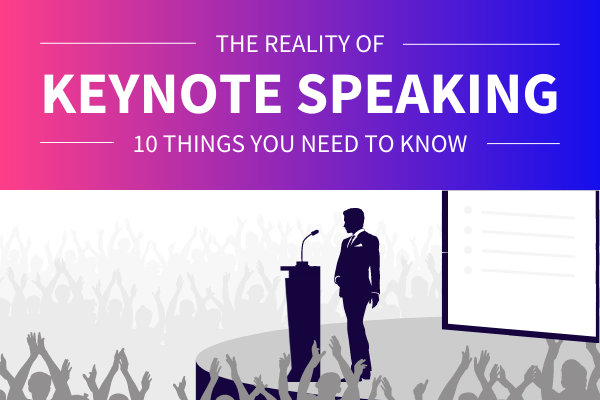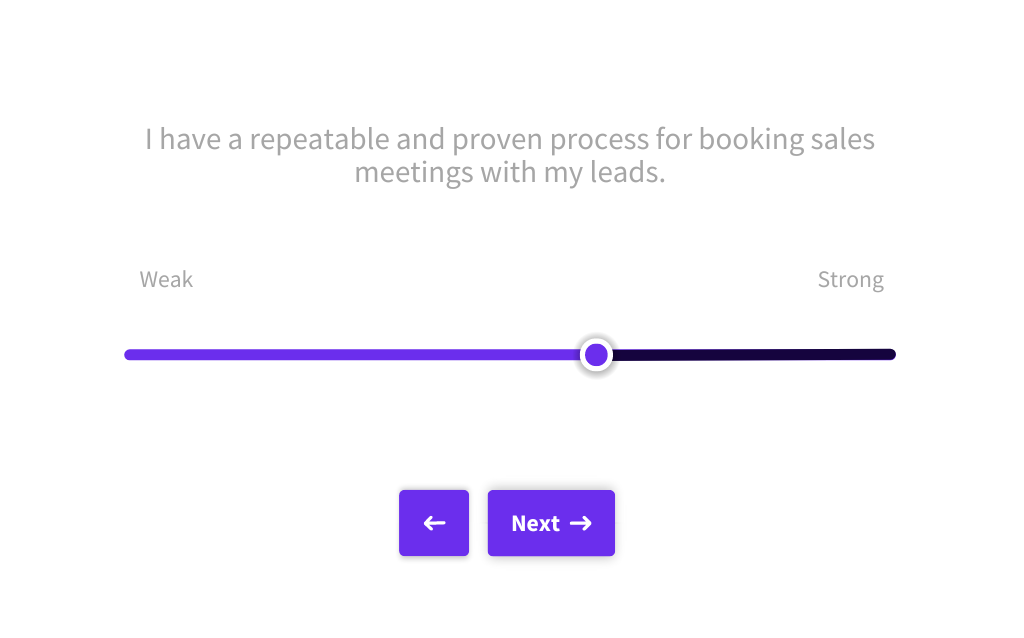Getting paid to speak easily sounds like a dream job, but that doesn’t mean it’s the right option for everyone. There are a lot of realities of keynote speaking that aren’t widely known, and these lead to a lot of misunderstandings. A keynote speaker has the power to make or break the entire event. Still, it’s not as easy as taking to the stage and sharing your ideas.
In reality, if keynote speaking was as easy as it looks, everyone would do it. These speakers are usually at the top of their fields. Not only are they respected amongst other speakers, but they’re viewed as trusted industry experts.
While it’s easy to be impressed by the effortless nature of the keynote speakers you see on the big stage, reality tells a different story. New speakers don’t usually get to peek behind the scenes to see what these preparations are really like. While some keynote speakers are professional speakers, many do more than just speak. If you want to be a wealthy speaker, you have to treat your practice like the business it is.
There are a lot of reasons to want to give a keynote speech. This is a signal of prestige, and it can really help you build a name for yourself. More importantly, it’s a marketing tool that leads to more referrals, opportunities, and paid gigs in the future. While interest and confidence are great first steps, it’s important to understand the realities of keynote speaking. In this guide, we’ll pull back the curtain on keynotes to share 10 things you need to know.
- You have the greatest impact when you focus on one big idea.
- Even the most experienced speakers need continuous practice.
- Sales skills are vital even if you’re not a sales speaker.
- High-quality speaking materials go a long way.
- Keynotes won’t usually “come to you.” You have to reach out.
- The biggest sales combine pre-, mid-, and post-event value.
- Systems are the key to a scalable sales process.
- You can’t outsource anything before mastering it yourself.
- Every gig is a chance for you to form a long-term partnership.
- Success comes from being an expert first and a speaker second.
You have the greatest impact when you focus on one big idea.
First, if there’s one thing you can learn from the best keynote speeches it’s the power of niching down. As the best marketers say: niches lead to riches. If you want to be successful on the stage, you need to know exactly what you’re talking about and who you’re talking to. Having a single big idea will always be more powerful than trying to cover everything in a wide topic.

To start, consider the big picture. What are you good at? Can you find a niche that overlaps with your real-world or professional passions? This is how you stand out. From there, dig out your niche even further.
For example, your niche as a sales professional might be to help companies provide outstanding customer service. While this is a great first step, you can take it even further. Instead, you might specialize in helping small businesses with under 50 employees connect with customers through automated sales channels. This is the kind of small niche that you can personalize to suit different keynote speeches, brands, and goals.
When you focus on a single big idea (vs. many), you learn the real needs of your audience. It’s tempting, especially when you’re first getting started, to try to do it all. By doing this, you might just fall into the background. Your goal isn’t to be the best professional keynote speaker ever. It’s to be the best keynote speaker for your audience and topic.
Even the most experienced speakers need continuous practice.
Next, there’s no such thing as getting too comfortable in the speaking space. Even the most experienced speakers are always improving. You need to continuously advance your keynote, presentation skills, and sales expertise. There’s no such thing as a perfect professional speaker. Everyone is a work in progress, and that’s good news for the whole industry.

It’s not just what you say that matters. It’s how you say it. Things like your posture, hand movements, and voice all add up. So does the way you deliver your speech, how you inflect your words, and so on. The more you refine these skills, the more confident and trustworthy you appear. While it’s true most of your heavy lifting will be done upfront as you gain your foundational skills, this is a never-ending process.
How do you continue to practice as a keynote speaker?
- Internalize your speech: The sooner you learn your keynote speech, the more time you have to get intimately familiar with it. By the time you present, you should know your speech inside and out.
- Record yourself: Another pro tip is to practice by recording yourself. While it might feel awkward to watch yourself back, the camera notices things others don’t.
- Ask for reviews: Solicit reviews from past clients and audiences. Take these seriously, and consider ways you can do better.
- Put yourself out there: Of course, take advantage of opportunities to put yourself out there, like podcast guesting, video collaborations, and more.
- Watch successful speakers: Lastly, watch some of the top speakers in your industry. What do they do well? What can you learn from them?
Sales skills are vital even if you’re not a sales speaker.
Third, it doesn’t matter whether you consider yourself a sales speaker or not. Sales skills are always important. Though the ultimate goal, for many speakers, is to outsource your sales process, you should always be prepared to sell yourself. As the face (and voice) of your keynotes, you are your own biggest advocate.

The best speakers are always improving when it comes to their sales skills. You might be surprised to hear this doesn’t always come naturally, and that’s okay. Your goal is to communicate your value to prospective clients. If you find the right fit, it will be mutually beneficial for both you and your client.
Remember, your keynote is high value and meaningful. Why shouldn’t you be ready to share how awesome it is with prospects? When you change your perspective on sales to one from a position of helpfulness, it makes all the difference. Better yet, the right sales skills go beyond just helping you promote yourself. They also transform you into a stronger thought leader in your area of expertise.
Whether you’re just getting started with sales or more experienced, it’s always a good idea to master the basics. Things like active listening, body language, and expertise help you grow comfortable with the act of selling yourself. From there, it’s all about practice.
High-quality speaking materials go a long way.
Furthermore, the best speakers don’t market themselves on their own. They use a host of supportive speaking materials. These include headshots, speaker bios, program descriptions, speaker intros, and bios. You can even look at your marketing tools as a part of your keynote speaking. This broadens the list to your website, social media, and branding.
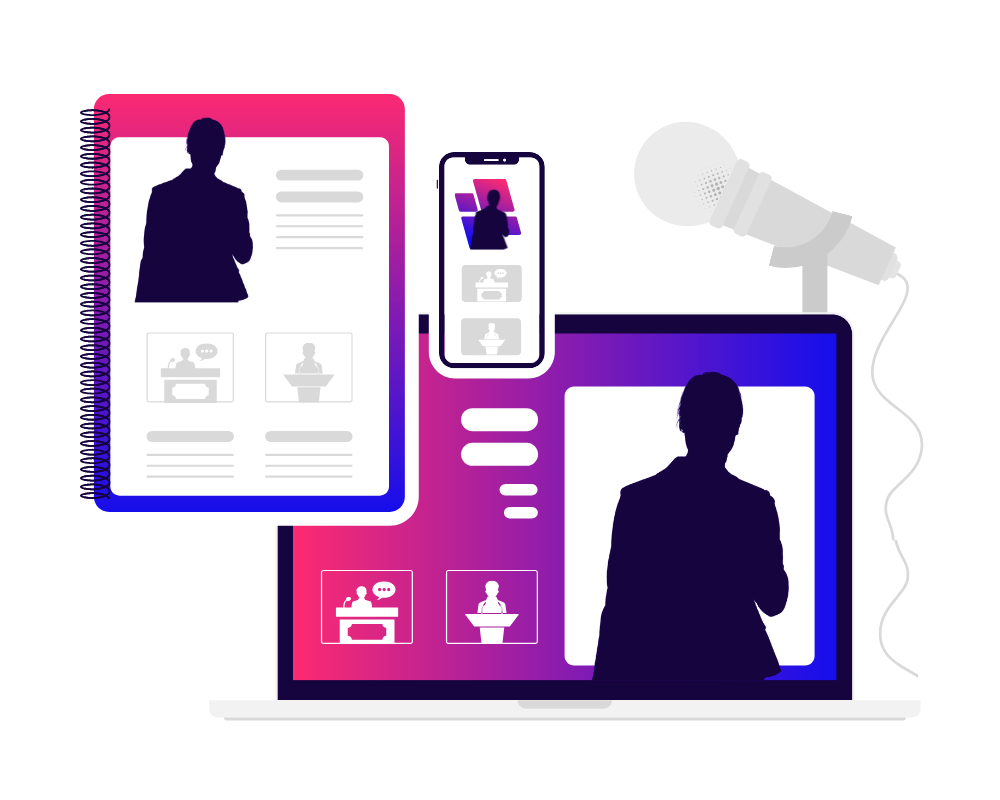
All of these things fall under the umbrella of your business. Everything needs to be up-to-date and professional. From your online presence to your speaker bio, be a strong advocate for yourself. While these things might seem secondary to your skills as a keynote speaker, they’re a part of your first impression. It takes between 5 to 7 impressions to even start creating awareness of your brand. Each touchpoint should be noteworthy and memorable.
The good news is you don’t have to hire a full-time graphic designer or social media manager. If you can dedicate a bit of time upfront to making sure your website is engaging and your branding is consistent, this makes all the difference. Anything you share in a sales conversation should match your brand.
Ultimately, this is all a way to show you’re professional and trustworthy. If your website looks haphazardly thrown together and you don’t have an up-to-date speaker profile, you’re not making a professional first impression. On the other hand, the opposite has the power to improve your overall marketing potential.
Keynotes won’t usually “come to you.” You have to reach out.
Additionally, one reality of keynote speaking that’s a hard pill to swallow is just how much work goes into finding the right prospects. Keynotes aren’t likely to fall into your lap. Those who have these opportunities given to them either know the right people or have decades of experience and brand awareness.

Instead, you have to reach out. This is again why sales skills are so essential. You need to build time to prospect and find your ideal clients for your business process. You need to not only know where to find these clients but how to reach out to them in a proactive, genuine way. There are a lot of effective ways to find the right events in your niche:
- Community: To begin, always be an active member of your community. Where are people in your industry spending time?
- Competition: Have your top competitors given keynotes in the past? Many of these events are likely to be a good fit for you in the future.
- Targeted search: Use keywords related to your industry to find events that already exist in your space. Some ideas include “Florida marketing conference” or “wedding planner conference.”
- Networking: Don’t underestimate the power of knowing the right people. Joining groups like speaker associations or online communities can be a proactive way to source leads and build long-term relationships.
Don’t get disheartened if events aren’t falling in your lap. Luckily, throughout your career, you build a stronger network of colleagues and clients, increasing the likelihood of these opportunities in the future.
The biggest sales combine pre-, mid-, and post-event value.
Next, many new keynote speakers focus solely on their actions at the event. While the mid-event experience is undoubtedly important, it’s only one part of the greater picture. The best way to harness your sales potential is by focusing on pre-, mid-, and post-event value. Not only should you be accessible before and after the event, but you can leverage your expertise to grow your revenue long-term.

The easier you are to work with from start to finish, the easier it becomes to secure referrals and reviews. Who doesn’t want repeat business? As you gain experience, it becomes even easier to promote yourself both before and after an event.
How can you increase your sales value throughout the lifecycle of an event?
- Before: Highlight the event on social media, send promotional emails and enticing snippets to your client for promotional use, and accept media requests.
- During: Upsell your keynote speaking services by offering add-ons like workshops, Q&As, panel participation, and promotional materials for guests. Be available throughout the whole event to answer questions, sign books, and network.
- After: Follow up with the event coordinator for feedback and potential future opportunities. Share moments from your keynote on social media and your website, using this as a form of social proof.
This doesn’t have to be a lot of work on your end, either. You can pre-schedule many social media posts in advance, and you can build existing keynote speaking packages into your business offerings.
Systems are the key to a scalable sales process.
Speaking of hitting the ground running, you need systems to scale your keynote speaking skills. While the majority of professional speakers are solopreneurs, that doesn’t mean you have to grind away for hours in front of the computer sending cold pitches each day. Having sales tools like a CRM dialed in makes it easier to sell efficiently.

If you’re working alone, you need safeguards to keep leads from falling through the cracks. Nobody wants to spend hours sorting through inbox clutter and email back-and-forth. As a speaker, it’s your goal to spend the most time talking to event organizers or making your mark on the stage.
Luckily, you’re working in the digital age. Many of the top CRMs are easy to automate for your sales needs. Better yet, SpeakerFlow’s CRM is an ecosystem built specifically by speakers for speakers. This means you can manage all of your sales, marketing, and admin tasks in a single place without stress. Your business doesn’t have to be complicated, but it does need to work for you.
Your CRM isn’t the only thing you can automate. With 80% of top-performing brands relying on some form of marketing automation, there’s no reason to work harder when you don’t have to. The list of things you can automate and create systems for is endless: social media, email marketing, chatbots, review requests, and so much more.
You can’t outsource anything before mastering it yourself.
With that in mind, you might be thinking why not just outsource all those tasks you don’t have time for? While outsourcing is the goal for many solopreneurs, don’t move too quickly. You can’t outsource anything before you first master it yourself. This isn’t just for sales (as we explained above), but also for marketing, operations, and admin tasks.
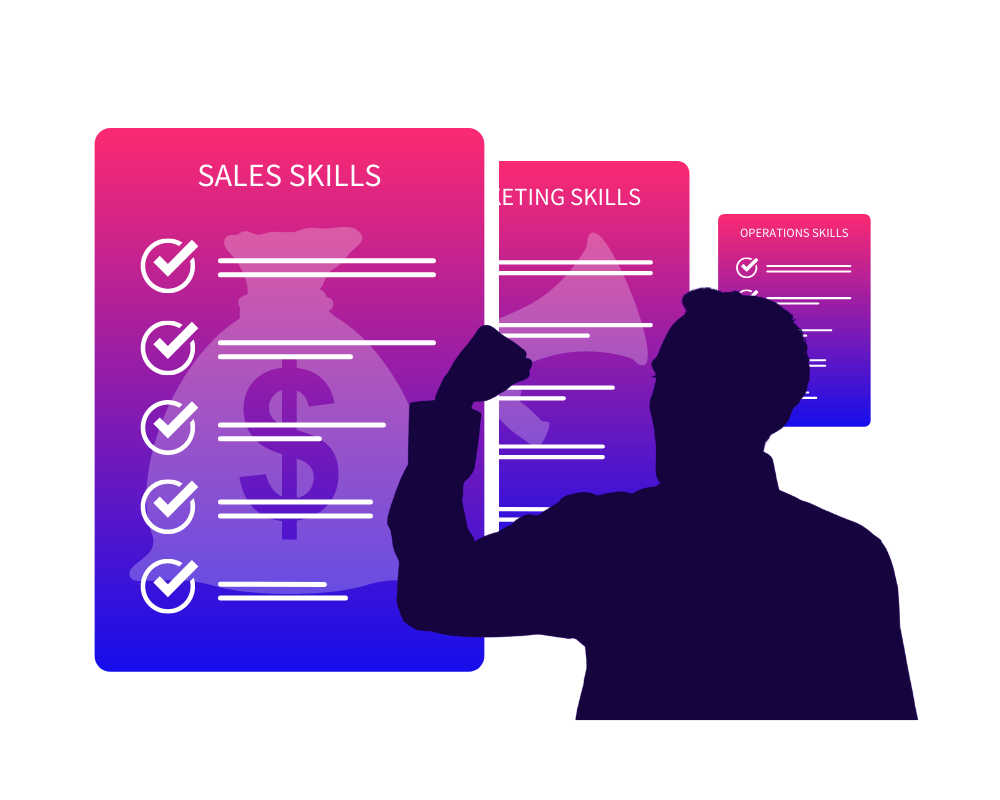
Since you’re the sole face of your business, you should be completely familiar with every aspect of it. Even if you choose to outsource in the future, you should know your goals, your metrics, and what’s important to you. While you don’t have to become a social media or content marketing expert overnight, you should feel comfortable writing your own Tweets and Instagram posts, for example.
Even if you outsource to a top agency or professional, you’ll still be the best source of information about what makes your speaking skills different. At the end of the day, the only one responsible for ensuring an exceptional experience for clients and your audience is you.
Even if you have the greatest team behind you, there’s no such thing as being too comfortable. One prime example of this is the COVID19 pandemic. When this hit in 2020, only those willing and able to adapt to changes survived (and thrived). On the other hand, many contractors took on full-time jobs and left speakers on their own with their business practices. You should always feel confident at the helm of your own business.
Every gig is a chance for you to form a long-term partnership.
Additionally, every keynote speaking engagement is more than just a speech. It’s a chance to build your business. There are so many ways to leverage your time spent on the stage, and many of these you might not even have thought of. Most of today’s top speakers aren’t just earning revenue through their speaking. They also use some combination of the following:
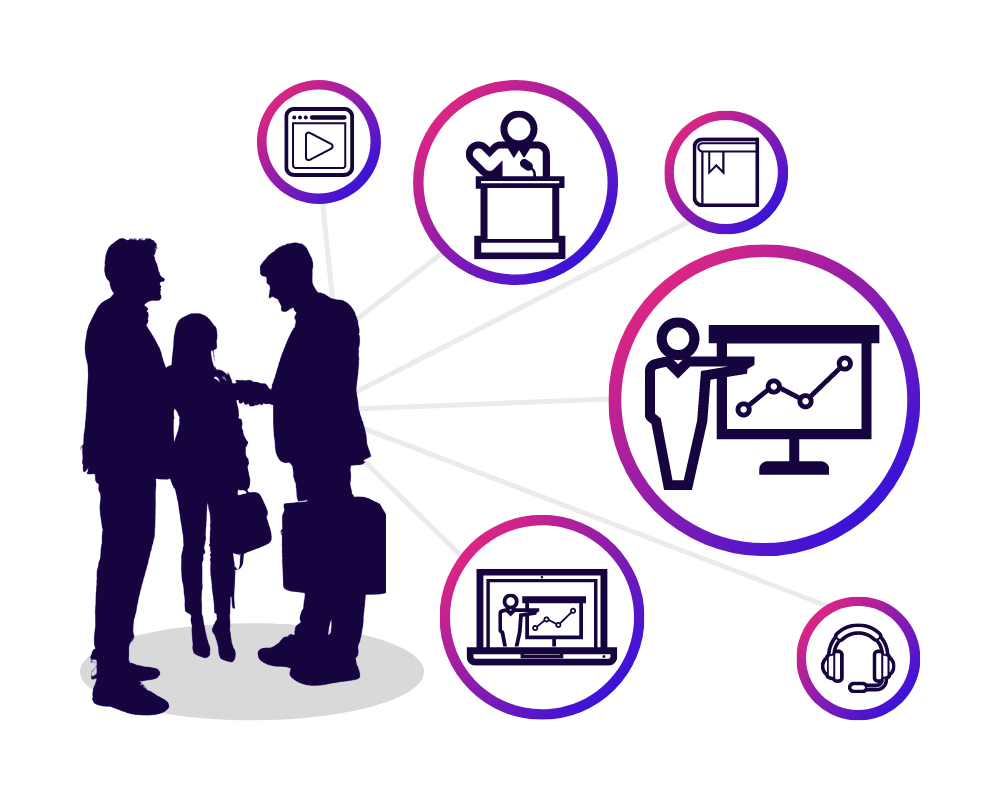
- Training seminars
- Workshops
- Published books
- Downloadable guides
- Courses
- Webinars
- Brand partnerships
- Affiliate marketing
- Professional consulting
When you put yourself out there as a keynote speaker, you have the chance to refer future customers, earn repeat business, and even create spin-off businesses. There are so many possibilities that come with speaking.
Ultimately, most speakers value having a diversified income. As we’ve said, there’s no such thing as getting too comfortable. The more revenue streams you have, as well as a strong network, the more secure your career becomes. This is how you future-proof your business, creating something long-lasting.
Success comes from being an expert first and a speaker second.
Lastly, one of the biggest realities of keynote speaking has to do with how you think of yourself. Yes, speaking is a huge part of being a keynote speaker. However, it’s not usually your primary title. As a keynote speaker, you’re an expert first and speaker second.

When you think of the most well-known speakers today, you likely recognize their thought leadership most of all. While they undoubtedly have strong speaking skills, this isn’t what sets them apart. As an expert, you have something of value to talk about. This is what event planners are willing to pay for.
The good news is that thought leaders can come from anywhere. If you understand your industry and the expertise you have to offer your community, this is where you truly shine. It’s not enough to proclaim yourself an expert. This is a title that’s earned through your content, expertise, and network. By collaborating with others, demonstrating your value, and providing an excellent experience, you slowly but surely become an expert.
Now, you know what it really means to be a keynote speaker. While having a big idea or “key note” to focus on is the right first step, you have to learn how to position yourself. Yes, you’re a speaker, but you’re also an expert. When you treat your keynote speaking as the business that it is, your opportunities are endless.


